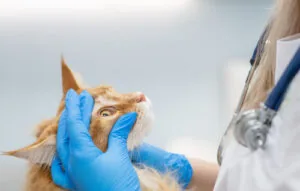Anal Gland Problems in Dogs

What Is the Purpose of My Dog’s Anal Glands?
Anal glands, or anal sacs as they are sometimes called, are small paired pouches located between the internal and external anal sphincter muscles, one on each side of the anus at roughly the 4 and 8 o’clock position. They empty through short and narrow ducts just inside the anus. Each sac is lined with abundant, modified sebaceous (oil) and apocrine (sweat) glands. The secreted substance is normally an oily, brownish fluid that packs a strong odor. It turns out there are a couple of purposes for these glands. One is to help your pup leave his signature scent behind, thereby marking territory. This is why dogs are so interested in sniffing one another’s hindquarters. These glands also help ease the transition of your dog’s stool out of his body and onto the ground. The problem occurs when the glands become impacted, or there are other complications.
Signs of Impacted or Infected Anal Glands
While dog scooting could be one possible symptom of anal gland problems, this behavior could have other causes, such as parasites or digestive problems. Or, it could simply be an itchy butt. Typically, a dog with impacted anal glands will scoot more than once or twice, and can also usually be seen licking their rear end. Redness or swelling around the sphincter is an indication that the glands are becoming infected, as is blood or puss in your dog’s stool or left behind on the carpet after they’ve finished scooting. Another cause of recurrent anal sac disease is change in stool consistency. This can occur in dogs with gastrointestinal diseases such as food allergies and inflammatory bowel disease.
What Causes Anal Gland Issues?
There are multiple causes for anal gland issues and there can be more than one underlying factor at a time.
Abnormal anatomical structure of the anal gland and/or duct
Some pets are born with abnormal (e.g. narrow, kinked) ducts, obstructing the flow of the anal gland secretions. Other pets with recurring anal gland issues can also develop narrow ducts due to all repetitive inflammation in the area and the subsequent formation of thickened scar tissue.
Obesity
Obese animals are more prone to anal gland problems compared to slimmer pets. While the exact mechanism is unknown, it is suggested that the extra body fat causes a “cushioning” effect which results in less pressure being applied on the anal glands during defecation.
Food/environmental allergies
Some dogs with underlying food or environmental allergies are more prone to anal gland issues. This could potentially be due to the inflammation resulting in a narrowed duct or an increase in anal gland secretions, both of which can result in incomplete emptying of the anal glands.
Inconsistent stools (e.g. diarrhea, constipation)
Dogs with inconsistent stools will often also have impacted anal glands because their feces are too soft (e.g. diarrhea) to express the anal glands or they are not expressed regularly enough (e.g. constipation).
How Is Anal Sac Disease Treated?
The treatment for impaction is to express the sacs and flush out the solidified material. Infusing the affected sac with anti-inflammatory and antibiotic medication may also be required. Because this can be painful, treatment may require sedation. For infection, the sacs must be expressed, and oral antibiotics may be administered to kill the bacteria. Most dogs will respond well to pain relief medications and antibiotics, such as amoxicillin-clavulanic acid (Clavamox®) or clindamycin (Antirobe®), that are prescribed for several days until the swelling and inflammation have subsided. Your veterinarian may also recommend using warm compresses for additional pain relief. Your veterinarian will let you know when your dog should be reassessed. This reassessment will likely include expressing the anal glands again and may require a repeat infusion of anti-inflammatory and antibiotic medication. If the anal sacs are abscessed but have not ruptured, surgical treatment to lance the abscess may be necessary.
Preventing Dog Anal Gland Problems
Your veterinarian may recommend a diet change. For some dogs, an increase in fiber can help firm up stools. You might also try a protein-based food that your dog isn’t used to eating. A constant diet of just one or two types of protein can trigger an allergic inflammatory response. Unaddressed food allergies are a quite common cause of chronic anal sac issues. When you change up your dog’s diet with new types of protein, that can help, but you should always consult your veterinarian regarding allergy testing. Another way to prevent impacted anal glands is to walk your dog frequently and keep him at a healthy weight. Dogs that are overweight and/or don’t get enough exercise are at greater risk.
Share This Post
Recent Posts
About Shallowford Animal Hospital
Shallowford Animal Hospital and The Pet Spa at Shallowford are dedicated to the exceptional, compassionate care your pet deserves. Pets hold a very special place in our families, and we treat yours like our own.



